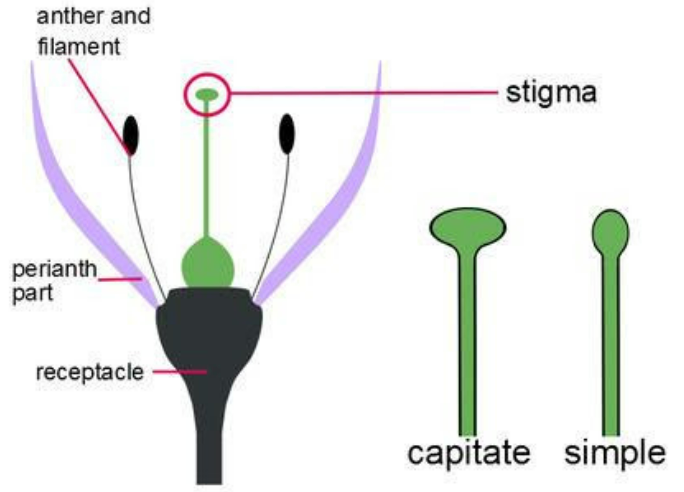
In which type of flower, stigma is rough and sticky?
Answer
393.3k+ views
Hint: In the gynoecium of a flower, the stigma is the receptive tip of a carpel or many connected or fused carpels. The stigma is divided into lobes such that it can be trifid (or three lobed) and it can also look like the head of the pin.
Complete answer:
As part of the gynoecium, or female reproductive organ of a plant, the stigma, style, and ovary (usually termed the stigma-style-ovary system) make up the pistil. There are stigmatic papillae that contain cells that are receptive to pollen in the stigma, which is located at the distal end of the stylodia. Unless they are wind pollinated, they can cover a large surface area. On the stigma, the pollen particle germinates. Stigmas are often sticky and include a variety of hairs or flaps to capture and trap pollen.
Following is the Image showing Stigma

Wind-borne pollen (anemophily), insects or other animals (biotic pollination) or, in rare circumstances, water can be used to collect pollen in some cases. Depending on the species, the stigma might be long and thin, round-shaped, or feathery.
When pollen leaves an anther, it is usually quite dry. As it turns out, stigma may help pollen dry up and germinate by rehydrating it and encouraging germination of the pollen tube. In addition, the stigma ensures effective adherence of the right type of pollen. When it comes to pollen discrimination and self-incompatibility reactions, stigma can play a significant influence.
As a result, the stigmas of anemophilous flowers are usually rough and sticky. Anemophily, or wind pollination, is a method of pollination in which pollen is spread by wind. Small, inconspicuous anemophilous (wheat, rice, corn) flowers do not have a smell or nectar. It is possible for the anthers to generate a great number of pollen grains, whereas the stamens tend to be lengthy and protrude out of the flower in general.
Note:
Wind pollination syndrome caused by anemophilous flowers is characterised by a lack of fragrance production, a lack of noticeable flower parts, a reduced proportion of nectar and an abundance of pollen grains. These flowers differ greatly from entomophilous (insect pollination) and zoophilous (pollination by animals) species.
Complete answer:
As part of the gynoecium, or female reproductive organ of a plant, the stigma, style, and ovary (usually termed the stigma-style-ovary system) make up the pistil. There are stigmatic papillae that contain cells that are receptive to pollen in the stigma, which is located at the distal end of the stylodia. Unless they are wind pollinated, they can cover a large surface area. On the stigma, the pollen particle germinates. Stigmas are often sticky and include a variety of hairs or flaps to capture and trap pollen.
Following is the Image showing Stigma

Wind-borne pollen (anemophily), insects or other animals (biotic pollination) or, in rare circumstances, water can be used to collect pollen in some cases. Depending on the species, the stigma might be long and thin, round-shaped, or feathery.
When pollen leaves an anther, it is usually quite dry. As it turns out, stigma may help pollen dry up and germinate by rehydrating it and encouraging germination of the pollen tube. In addition, the stigma ensures effective adherence of the right type of pollen. When it comes to pollen discrimination and self-incompatibility reactions, stigma can play a significant influence.
As a result, the stigmas of anemophilous flowers are usually rough and sticky. Anemophily, or wind pollination, is a method of pollination in which pollen is spread by wind. Small, inconspicuous anemophilous (wheat, rice, corn) flowers do not have a smell or nectar. It is possible for the anthers to generate a great number of pollen grains, whereas the stamens tend to be lengthy and protrude out of the flower in general.
Note:
Wind pollination syndrome caused by anemophilous flowers is characterised by a lack of fragrance production, a lack of noticeable flower parts, a reduced proportion of nectar and an abundance of pollen grains. These flowers differ greatly from entomophilous (insect pollination) and zoophilous (pollination by animals) species.
Recently Updated Pages
Master Class 11 Economics: Engaging Questions & Answers for Success

Master Class 11 Business Studies: Engaging Questions & Answers for Success

Master Class 11 Accountancy: Engaging Questions & Answers for Success

Master Class 11 English: Engaging Questions & Answers for Success

Master Class 11 Computer Science: Engaging Questions & Answers for Success

Master Class 11 Maths: Engaging Questions & Answers for Success

Trending doubts
Which one is a true fish A Jellyfish B Starfish C Dogfish class 11 biology CBSE

State and prove Bernoullis theorem class 11 physics CBSE

1 ton equals to A 100 kg B 1000 kg C 10 kg D 10000 class 11 physics CBSE

In which part of the body the blood is purified oxygenation class 11 biology CBSE

One Metric ton is equal to kg A 10000 B 1000 C 100 class 11 physics CBSE

Difference Between Prokaryotic Cells and Eukaryotic Cells




